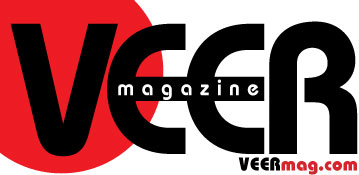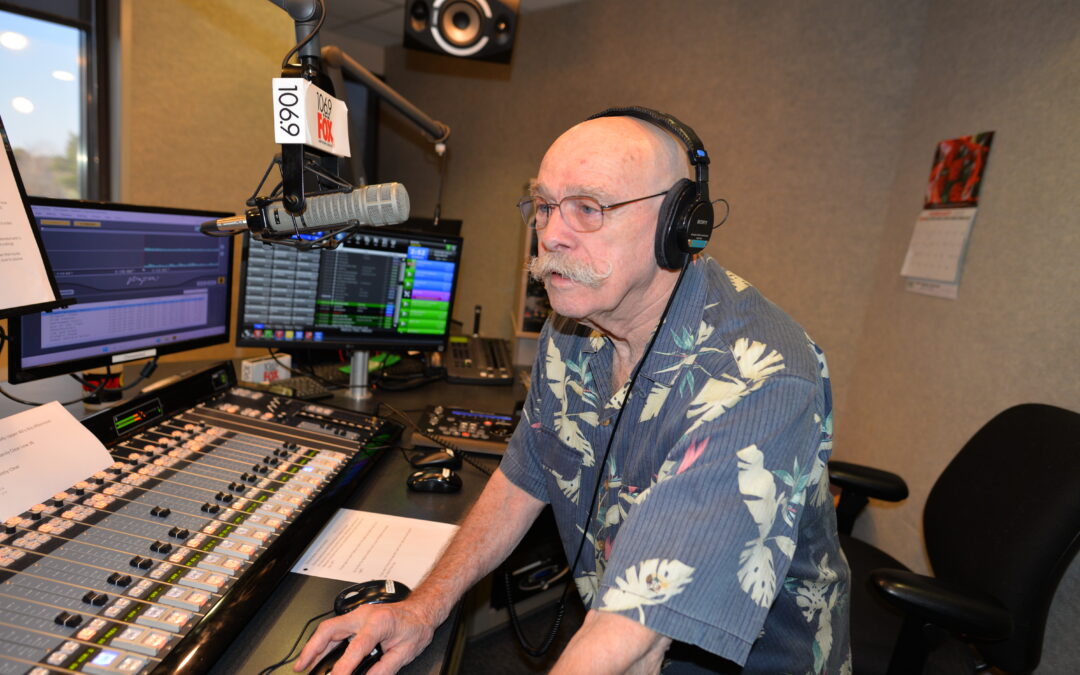(Arlo working the board before his 10 AM to 3 PM mid-day shift in February 2025. Photo by Jeff Maisey)
By Jeff Maisey
“The enormity of the importance of Mike Arlo in our lives can best be described by imagining what the past 50 years would have been like without him: as unimaginable as life without our beautiful ocean and seashore itself,” reflected National Public Radio theme song composer BJ Leiderman.
Like Leiderman, who has been known to pop into town to join friends in the band Intangible Cats and play piano and sing lead on rock classics like Steely Dan’s “My Old School,” Mike Arlo was raised in Virginia Beach.
Both Leiderman and Arlo, along with an entire generation of Baby Boomers, were heavily influenced by the seemingly never ending supply of rock music released in the late 1960s and the 1970s. That golden era was without question the most prolific in the history of Western Civilization music, with every recording artist at the top of their game — The Beatles, The Rolling Stones, Pink Floyd, Queen, The Eagles, Bruce Springsteen, Fleetwood Mac, Led Zeppelin, The Who, Jethro Tull, Boston, Aerosmith, Elton John, Van Halen, Journey, Rush, Electric Light Orchestra (ELO), Doobie Brothers, David Bowie, Bad Company, Steve Miller Band, Tom Petty & The Heartbreakers…the list is long.
Mike Arlo, now at age 75 and spry as a fox, got his start as a disc jockey in 1975 — five decades ago. But that was after a roundabout way of getting an unexpected break.
Arlo joined the US Navy in 1966 during the Vietnam War, and exited the military in ’72.
“So I was in the Navy during the era of ‘Wooden Ships’ and ‘Iron Man,’” he said with his infectious laugh, signature smile, and handlebar mustache curled upward, referencing the timeframe with songs from Crosby, Stills & Nash and Black Sabbath.
Arlo served in Naval aviation. He volunteered by enlisting in the Navy because he didn’t want to find himself drafted as a Marine or by the Army.
“I wanted to do my part, but I didn’t want to eat out of a tin can or sleep in a hole in the dirt,” he said.
After the Navy, Mike Arlo returned home and worked a variety of jobs.
During his off-time, Arlo would frequent a restaurant/bar on Rosemont Road called La Casa Grande, in part, because the manager would allow him to run a beer tab. La Casa had a rotating roster of DJs play music for diners and barflies.
After discussions about music, the manger asked Arlo to bring his album collection in on Wednesdays and spin a progressive rock night.
One evening John London and Dan O’Brien, on-air disc jockeys at what was then called Stereo 99, were hanging out at the restaurant. They liked Arlo’s storytelling ability, outgoing personality, and the music he was playing. They struck up a conversation.
“They told me they were beginning to do this new thing called Album-Oriented Rock,” said Arlo. “They (the radio station) had a lot of Top 40 radio jocks who didn’t know the music.”
Arlo certainly knew the music inside and out, but commercial radio was another story.
“John made the comment, ‘I can teach a monkey to do that,’” Arlo recalled.
And so it began.
Arlo’s day job at that time was as a floating manager at Thrifty Car Rental. He’d met with the radio station’s program director and began filling in part-time on airtime shifts as needed.
Thrifty franchise owner Tom Smith allowed Arlo to take off, even at the last minute, for the opportunity to be on the air.
The radio station changed its brand name to FM99. Arlo’s first consistent stint was the midnight Sunday to 6 AM Monday shift.
Most radio stations at the time — like television — signed off the air at midnight with the playing of the National Anthem. FM99’s concept was to play 24/7 rock and roll.
“And I was up for that,” laughed Arlo in his festive blue Hawaiian print shirt.
Arlo’s passion for the music was immediately evident to listeners. While you couldn’t “see” Arlo’s wide grin, his enthusiasm came through the radio speakers loud and clear, and he resonated with audiences in an age where music history was being made weekly. As you were driving down the road or sunbathing on the oceanfront beach, Arlo would announce, something like, “Hey gang, here’s a brand new tune you’ll want to check out called “The Boys Are Back in Town” from Thin Lizzy. That passion secured him a full-time position.
The Album-Oriented Rock (AOL) was the perfect fit for Mike Arlo. AM frequency radio had long been the medium for country music, Top 40 pop, and Rhythm & Blues. The broadcast quality was thin and most folks listened on their car radio or hand-held transistor radios powered by a 9-volt battery. Songs played on AM stations generally clocked in in less than three minutes. Longer tunes required a “radio edit” version in order to get airplay. AM stations also tended to spin the same 20 songs repeatedly.
AOL formatted stations on the FM dial played their version of “hits” to anchor each hour, but the format excelled because disc jockeys were allowed to spin any song from the album (LP or Long Play). This included songs often at five minutes or longer.
“If you look back at the material that was coming out,” Arlo said, “from 1970 to the early ‘80s the creativity was just mind boggling.”
This made Arlo and AOL a match especially given his love for prog rock groups such as Yes, Genesis, Pink Floyd, Kansas, Jethro Tull, and Emerson, Lake & Palmer. The age of the concept album was made possible because of the AOR format.
FM broadcast frequencies were much higher in quality and thus popular with serious listeners with high fidelity tuners and home stereo systems. This was noted in Steely Dan’s song “FM” and the lyric “no static at all.”
Songs such as “Bohemian Rhapsody” (Queen), “Stairway to Heaven (Led Zeppelin), “Shine On You Crazy Diamond” (Pink Floyd), “Hocus Pocus” (Focus), “Do You Feel Like We Do” (Peter Frampton), “Funeral For a Friend/Love Lies Bleeding” (Elton John), “Don’t Fear the Reaper” (Blue Oyster Cult), and the full-length live version of Lynyrd Skynyd’s “Free Bird” would have never flown on AM radio.
Among the tricks of the trade Arlo learned quickly was cueing a song on a vinyl record album and have it seamlessly flow into the next tune. This art was dubbed a segue way.
“My favorite thing to do was go through the library and find two songs in the same key at the end and beginning and transition into the next. Oh, that was so much fun,” Arlo shared.
In today’s commercial radio, in-house libraries of vinyl LPs no longer exist. Long gone, too, are walls of CDs as well as songs and/or commercials on carts. Everything is digital.
Radio jocks once kept a log of the songs played on their shift. They often picked the tunes they wanted to play as part of their “show.”
That has also changed in commercial radio. The digital library is scaled down to a couple hundred test-marketed songs programmed by the station music director. A monitor displays a scrolling timeline of advertising commercials and songs that automatically play. The disc jockey (on-air personality) adds live (or pre-recorded) intros to songs and reads to occasional weather forecast.
The rock songs that Mike Arlo played at FM99 would become labeled “classic rock” in the early 1990s.
The music industry as a whole — record companies and radio — underwent a sea change. Up and coming bands such as Nirvana, Pearl Jam, Soundgarden, and Metallica served as a bridge between classic rock and new rock, also known at one point as Active Rock as a format.
The FM99 brand continued to play new rock recording artists. A sister station within the ownership developed WAFX 106.9 The Fox as the home of Classic Rock.
Record companies were fickle on releasing new material from classic artists unless they were proven high-volume sellers. The labels also showed no desire for the same frequency from recording artists as their primary interest shifted. Recording artists such as Rod Stewart and Elton John were relegated to a radio format known as Adult Contemporary for new releases.
Classic Rock stations played the “classics” from Tom Petty, Kiss, Kansas, and Styx, but gave no love to new releases for touring classic rock artists. “Classic” would come to mean released from 1967 through 1991.
Interestingly, according to Arlo, Fred Jacobs, a radio industry consultant that designed the “classic rock” format, tested it on FM99’s AM 1230 sister station.
“We tried it out and it sounded really good,” Arlo explained. “It was the really popular rock songs. The deep cuts all disappeared with that format.”
Still the classic rock format remains extremely popular as a radio program as is evident with 106.9 The Fox. People — listeners — as Arlo will tell anyone — want to hear their favorite songs, those that are familiar and take them to a happy place in their memories.
“As Jimmy Buffett said: ‘Songs we all know the words to,’” reminded Arlo.
It is said the songs people listened to in their high school and college years are the ones they want to hear for the duration of their lives, hence the “soundtrack of our lives” phrase. Baby Boomers still represent a huge radio listenership slice wanting to hear those classics over and over again, no longer in a quest to discover that obscure group that never made it big like an Angel, Renaissance, April Wine, Wishbone Ash, or Uriah Heep that may a aired a few times at night on FM99 in 1976.
For Arlo, that 6 PM to midnight shift was magical back in the day.
“Oh my goodness, what a great spot in the 1970s when we were running a 20 share at night,” he said. “I mean 20 percent of people with a radio on were tuned-in to our radio station. It was glorious radio. I was able to program whatever I wanted.”
While Arlo was require to play a certain number of “hits” or songs deemed popular “recurrents,” he had free reign for the majority of his shift.
“For those of us that loved music it was a joyous time,” Arlo said. “For anybody that wasn’t as knowledgeable or didn’t have a passion, it was torture. That was the separation between the really good jocks and those that were just sitting in their chairs playing (any) music.”
At this stage in his career, Mike Arlo enjoys the freedom to extend those programmed talking spaces. He’s allowed to share some of those stories about the origins of songs, the bands, and the celebrities he’s met and interviewed. The short Arlo’s Archives and hour-long Electric Lunch segments within his 10 AM to 3 PM air shift allow for some of that vintage creativeness of yesteryear.
For radio listeners in Hampton Roads who tune in to 106.9 The Fox, not only are they treated to a daily serving of their favorite rock songs, they get to the hear from an old friend who has been a part of their lives for 50 years — Mike Arlo.
“The songs bring back memories of who you were with, what you were doing, and where you worked when you heard them. That’s the wonderful thing about this format. It’s a stroll down memory lane whenever you turn it on.”
In the golden age of radio, the best jocks would have a signature sign-off to conclude their on-air shift.
For Arlo, everyone knows upbeat toned “Bicycle — make it a great day.”
“I had a friend who used to say ‘Bi…cycle.’ It was a cool catch phrase so I borrowed it. But the important part is ‘Make it a great day,’” Arlo said, “because you can really screw up a great day with a bad attitude. My whole thing was keep a positive attitude and good things will happen.”
EXTRA, EXTRA
What comes to mind when you think of Mike Arlo?
Arlo is the human embodiment of sunshine. He makes people feel better. He’s warm and life-affirming. He loves people. He’s always in a great mood (even when he’s not) and the smile in his voice is authentic. Arlo’s success is due to many things, but being NICE is high on the list. — Mike Beck, Program Director, WNOR FM99 and WAFX-FM The Fox
A very nice fellow and a talented broadcaster. — Tony Macrini, longtime WNIS Talk Show host
Arlo is a treasure and Hampton Roads is lucky to have his talent all these years. His love for music and his kindness can be heard through the radio. When I see him, I can’t help but smile. — Ken MacDonald, President, IMGoing Events
A incredibly talented and knowledgeable radio DJ that knows more about rock music than anyone. It’s Mike huge personality, infectious smile, handlebar mustache, and a best friend to everyone who has ever listened to him, that has made him into a local radio legend. I had booked John Entwistle of the Who at the Boathouse and ticket sales were horrible. Mike knew it and he helped me line up an on air interview with John which made a real difference. He’s that kind of guy. — Bill Reid, Co-Owner, Elevation 27
I was doing news at WNOR in 1975, coming in early in the morning as Mike was finishing his overnight shift, on FM. I recall his energy, even at 6 AM was tremendous. And then I was at WAVY doing sports while he was performing with Jerry Harrell taping Dr. Madblood. Mike is multi-talented, a real gift to our region. — Joel Rubin, President, Rubin Communications
Mike is a natural when it comes to his air work. Kind of like listening to the guy next door. A lot of folks grew up listening to Mike. He played rock music on the radio before it went Classic so he has some great stories about the songs. — Bill Bass, WNIS Radio
Mike has always come across as very genuine. Listening to him on the radio feels like having a conversation with someone who shares your musical taste and your cultural reference points. You truly get the sense that he loves this music and that he is connected to this community. When he first started, that was a common thing with DJs, but as radio has become more and more corporate, a guy like Mike really stands out. Even if you’ve never met him, or just heard his voice on the radio day after day, he feels like a friend. A cool rockin’ daddy, indeed. — Mike Holtzclaw, former Daily Press reporter
When listeners met Mike they found the genuine, upbeat, friendly guy they heard on the air. Mike never met a stranger. I truly admire him for that. — Bruce Garraway, former FM99 program director
First thing that comes to mind is his big grin, handlebar mustache and all. Then his laugh, and his sheer joy in living. People say James Brown is “the hardest working man in show business,” but I think it’s Mike Arlo. He’s been willing to do so many things, some of which were ill-advised, like wrestling a bear. He’s done on-location promotions where almost no one showed up, to being mobbed when he walks in the door. On the Madblood show alone, he has been a burned-up and restored vampire, a crashed crop duster, Fluke Skywalker, where I got to be the puppet Yokel and ride on his back, and even then, he is always willing to put on the Jinx mask and be a monster from the basement. He may have lost hair and lost physical height, but he is a giant in his field. — Debra Burrell of Norfolk Arts and also known as ”Script Goddess of Continuity and Cat Wrangler” for the “Dr Madblood” show.
The Grandaddy of Rock n Roll. Growing up in Tidewater in the 1970s ( and partying into the ’80s) FM99 was always playin’ the soundtrack of our generation. Arlo was always there to play OUR music. He’s not only cool, but he’s kind — he’s just a good guy. After all these years I see him as an icon, a living legend, and we are excited to honor him this year as the Grand Marshall of our St Paddy’s Day Parade in Ocean View! We are lucky he stuck around so long. — Peter Decker III, attorney
A true radio personality ( an anachronism these days)..someone who became the “Face” as well as The Voice, of a non-visual medium, which perhaps until recently is what “Radio” is. — Richard Spano, local musician
To me, local commercial radio is really about the personality/DJ because we can find the music anywhere these days. Radio has been getting away from that concept and Mike represents that era and has never let go. His positive energy and the crazy characters he has played on Dr Madblood make him stand out as the local boy who made good. He’s one of us and we could use more Mike Arlos. — Katherine Byrd, music listener
With his exuberant delivery between songs, you can just “hear” the smile on his face and visualize his famous mustache as he is talking. And you can’t forget his role on Dr. Madblood. — Thom Vourlas, Naro Expanded Cinema




